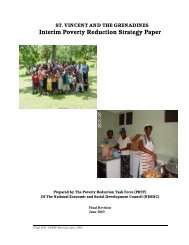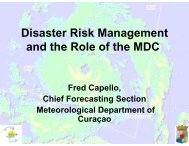The Anatomy of A Silent Crisis The Anatomy of A Silent Crisis
The Anatomy of A Silent Crisis The Anatomy of A Silent Crisis
The Anatomy of A Silent Crisis The Anatomy of A Silent Crisis
- TAGS
- anatomy
- www.bb.undp.org
You also want an ePaper? Increase the reach of your titles
YUMPU automatically turns print PDFs into web optimized ePapers that Google loves.
Critical areas <strong>of</strong> human impact<br />
but also include populations from China, and India. 155 In West Africa, a creeping desertification<br />
is in progress, with 1,350 square miles <strong>of</strong> Nigerian land turning into desert each year, uprooting<br />
farmers and herdsmen and causing internal migration towards coastal areas. In Burkina Faso,<br />
desertification is the single largest cause for migration to fast growing urban centres. <strong>The</strong> UN<br />
housing agency estimates that about one in three African slum dwellers could be considered<br />
environmental refugees, who have fled advancing deserts and failing farms. 156<br />
In the next 20 years the number <strong>of</strong> Climate Displaced People could more than triple<br />
<strong>The</strong> IPCC and the Stern review speak <strong>of</strong> 150 million and 200 million permanently displaced<br />
due to rising sea-levels, floods and droughts in 2050. <strong>The</strong>se are widely disputed estimates155 , but<br />
give an order <strong>of</strong> magnitude that shows that by 2030, the number <strong>of</strong> Climate Displaced People<br />
could at least triple. <strong>The</strong>y migrate because they are driven from their homelands by weather<br />
disasters or gradual environmental degradation that generates economic migration. 44,155 <strong>The</strong>se<br />
people leave a variety <strong>of</strong> different topographies, including small islands, low lying coastal areas,<br />
arid and semi-arid areas, forested areas and areas liable to forest decay. Regions prone to natural<br />
disasters, drought and desertification, high urban atmospheric pollution are also hit. <strong>The</strong> most<br />
seriously affected countries include island states, several African nations, China, India, Bangladesh,<br />
Egypt and the delta areas and coastal zones <strong>of</strong> several countries. 143<br />
It is not possible to say with certainty who will be Climate Displaced People in 2030, but<br />
vulnerability to displacement both to weather-related disasters and gradual environmental<br />
degradation is already enormous and it is growing with over 2.8 billion people vulnerable to<br />
weather-related disasters and sea level rise today. Furthermore, the poor are typically the most<br />
exposed—especially to the effects <strong>of</strong> more frequent and more intense weather-related disasters.<br />
Almost 160 million people currently living in low lying areas are believed to be at risk <strong>of</strong> flooding from<br />
storm surges. 143 Even more people are vulnerable to gradual environmental degradation through<br />
desertification and rising sea levels: Arid and semi-arid areas currently cover about 40 percent <strong>of</strong><br />
earth’s land surface and are home to more than 2 billion people. It is estimated that 135 million<br />
people — the combined populations <strong>of</strong> France and Germany — are at risk <strong>of</strong> being displaced by<br />
desertification. <strong>The</strong> problem is most severe in sub-Saharan Africa, the Sahel and the Horn <strong>of</strong> Africa.<br />
In sub-Saharan Africa alone, some 60 million are estimated to move from desertified areas to<br />
northern Africa and Europe by 2020. <strong>The</strong> World Bank estimates that sea levels rising a single meter<br />
would displace 56 million people in 84 developing countries. In Bangladesh alone, 20 million would<br />
be affected. 143<br />
49







